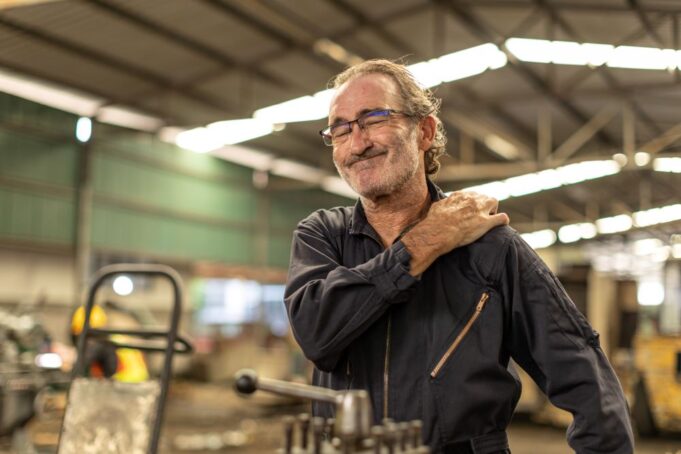Facilities technicians in hospitals move constantly through complex environments where physical strain is part of the job. Long hours on hard flooring, repeated crouching, bending, and lifting, and navigating cluttered or slippery surfaces all take a toll. Without proactive measures, these everyday movements increase the risk of musculoskeletal injuries, fatigue, and long-term physical limitations. Preventing these outcomes is possible with strategies that support the body through movement, footwear, and workspace design. When you take the time to address physical strain in advance, you protect both short-term safety and long-term function.
Stretching reduces strain and prepares your body for demands
Before beginning physically demanding tasks, your muscles need time to activate. Starting your day with dynamic stretches helps increase circulation and flexibility, which lowers the risk of pulling a muscle or tightening up during awkward movements. Leg swings, shoulder rolls, and gentle torso twists are effective at warming up major muscle groups. As the day progresses, repeated motions and awkward postures can create tightness in your back, shoulders, and legs. Static stretches during mid-day pauses help loosen these areas and allow your body to recover.
Recommended stretches for facilities technicians:
Dynamic (start of day):
- Leg swings (front to back)
- Arm circles
- Shoulder rolls
- Hip rotations
Static (midday or end of day):
- Calf stretch (against wall)
- Hamstring stretch (seated or standing)
- Upper back stretch (arms extended)
- Neck tilt stretch
Best practices for stretching include holding each stretch for at least 20 seconds and repeating the movement two to three times per muscle group. It’s beneficial to incorporate stretching into scheduled pauses or during transitions between tasks to ensure regular movement and recovery. Encouraging group participation can also help reinforce consistency and build a culture of injury prevention among team members.
Stretching also improves posture and balance, both of which protect against slips and falls in tight or cluttered maintenance spaces.
Footwear choice affects your comfort, balance, and endurance
Every step on a hard hospital floor sends impact up your legs and into your lower back. Footwear with the right design features protects your body from that force. Shoes with proper arch support help distribute weight more evenly and reduce strain in your knees and hips. Cushioning absorbs the impact of walking on tile or concrete, while slip-resistant soles reduce the chance of falling on a slick or wet surface.
Key features to look for in work shoes:
- Arch support for weight distribution and joint alignment
- Thick cushioning in midsoles for shock absorption
- Slip-resistant soles rated for hospital floors
- Breathable material to reduce moisture buildup
- Proper fit that allows toe movement without heel slippage
Footwear care tips:
- Replace shoes every 6 to 12 months depending on use
- Avoid shoes with worn soles or visible compression
- Rotate between at least two supportive pairs
- Avoid soft, unsupportive soles that flatten quickly
A shoe that fits poorly or lacks support leads to fatigue, which increases the likelihood of missteps or overuse injuries. Investing in quality footwear upfront reduces the risk of discomfort and long-term strain.
Ergonomic practices reduce repeated strain and awkward movement
Ergonomic thinking helps you adjust your tools, movements, and workspace to support your body. This does not mean investing in high-end furniture. It starts with examining how you reach for tools, how you lift, and how long you stay in one position. Adjusting tool height, handle design, or storage layout helps reduce awkward posture and unnecessary bending. For example, placing frequently used items at waist height saves your back from constant flexing.
Recommended ergonomic adjustments:
- Use carts and workstations that match your standing height
- Store heavy tools or equipment between knee and chest height
- Choose tools with padded grips and lightweight designs
- Avoid twisting while lifting. Pivot your feet instead
- Use step stools rather than overreaching
- Take short movement breaks every 30 to 45 minutes
Additional strategies to support ergonomic safety include participating in ergonomic assessments offered by safety teams, which can help identify areas for improvement. It’s also important to report any workspaces that involve repeated strain or awkward access points to prevent long-term issues. Training on proper lifting posture and maintaining correct joint alignment can further reduce injury risk. In areas where prolonged standing is required, using anti-fatigue mats can provide added support and comfort throughout the workday.
Educating yourself and your coworkers about early warning signs such as tingling, joint stiffness, or tightness in your lower back makes it easier to respond before those symptoms become injuries. Awareness is the first step toward prevention.
Building a routine that protects your body
When you approach physical work with habits that protect your body, you perform more efficiently and reduce your risk of long-term damage. Daily stretching prepares your muscles for physical activity and helps you recover from awkward positions. Reliable footwear reduces strain with every step and supports your posture throughout the day. Ergonomic adjustments minimize repeated stress and awkward movement, letting your body stay aligned while you work.
You may not always notice the immediate effects of these strategies. But over time, you will find that fewer aches and more consistent energy help you stay focused and move confidently through your responsibilities. Encouraging small adjustments, whether it is swapping shoes, adjusting a tool, or taking a moment to stretch, creates long-term results. Workplace safety in hospital environments starts with the choices you make before discomfort becomes injury. Investing in your own protection makes the work more sustainable and strengthens your role within the facility.
Sources
15 Best Workplace Stretching Exercises for a Healthier Office Routine
Enhancing Healthcare: The Role of Ergonomics for Safety & Efficiency
Ergonomic Footwear: Choosing Shoes for Comfort and Support
Ergonomics for Healthcare Environments
Footwear Features for Hospital Workers
The Benefits of Ergonomics in All Workplaces
The Importance of Ergonomics in Healthcare Facilities Beyond Physical Wellness
Workplace Ergonomics: Supporting Healthy Feet in Ottawa Offices






